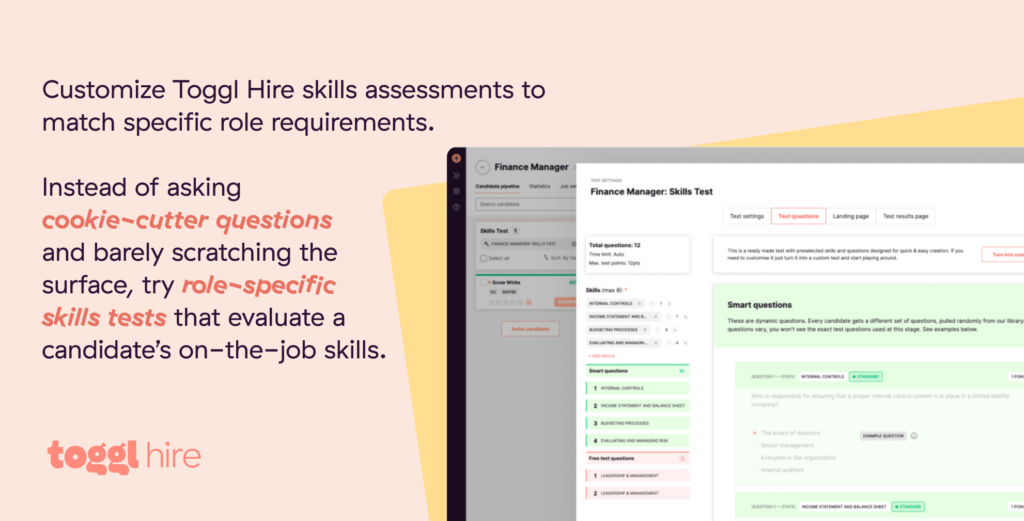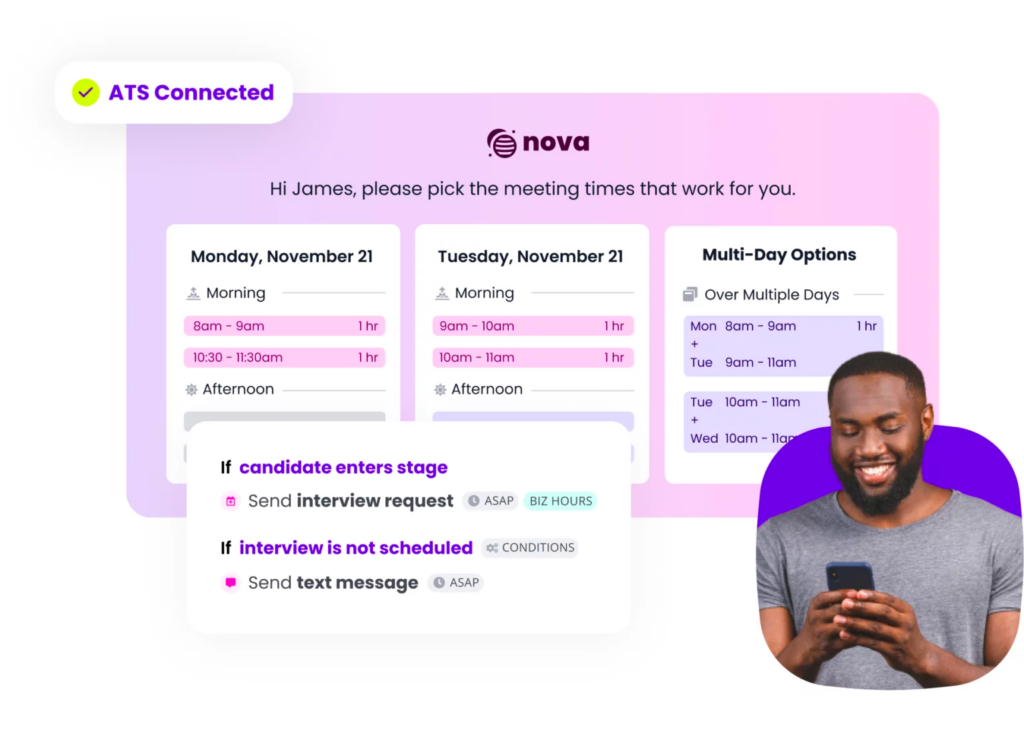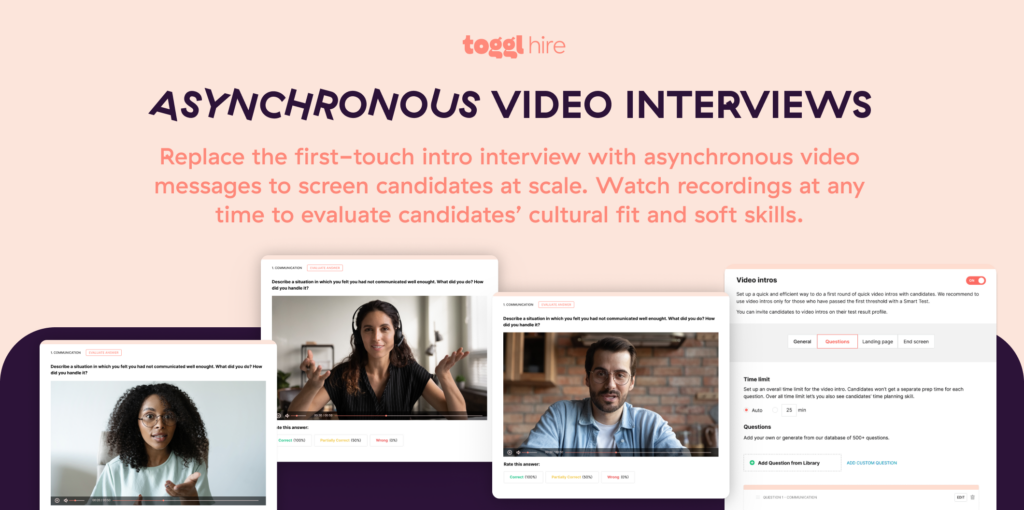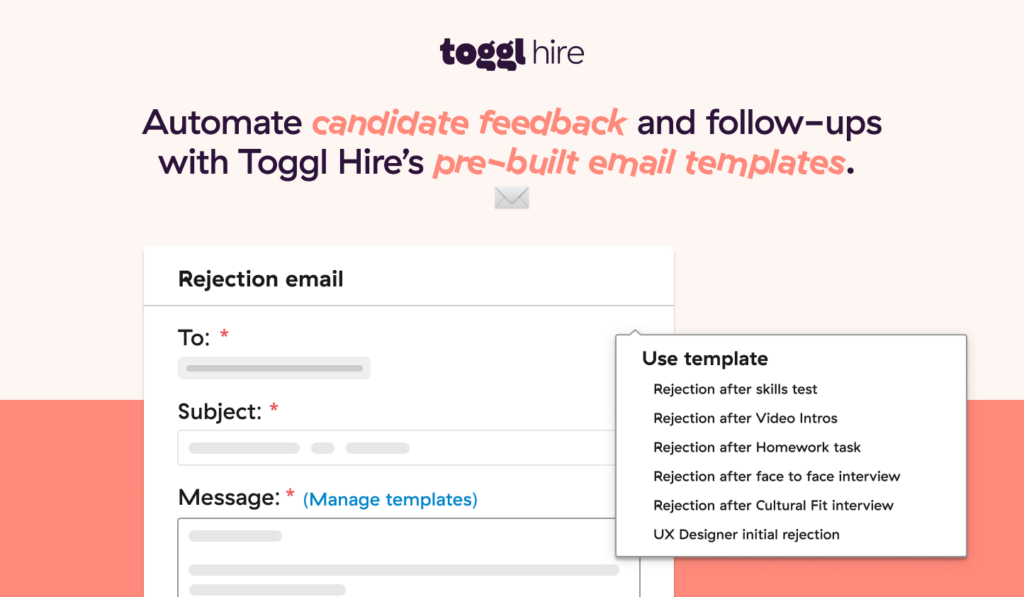The time to hire a new employee stands at an all-time high of 44 days, but ongoing talent shortages and a job market that currently favors candidates aren’t the only reasons for long hiring cycles.
Talent acquisition professionals also struggle to stay efficient when pressed with massive hiring volumes or hard-to-fill senior positions. Skills mismatches between advertised job openings and the candidates’ skill sets also increase the time and cost to hire (an issue that’s expected to get worse in 2024 and beyond).
So, more and more talent acquisition leaders turn to recruitment automation as the solution — and it proves to be an effective one! Here’s what to expect from the future of AI in recruiting and new technology to expect in the year ahead.
TL;DR — Key Takeaways
Recruiters waste anywhere between 10 to 20 productive hours per week on repetitive tasks, like candidate scheduling, document collection, and applicant pre-screening. Automation reduces manual effort, increases team efficiency, and ensures consistency in hiring processes.
Automation technology is rule-based and task-oriented. It includes all your favorite HR tools — people management platforms, skills assessments, and interview scheduling tools, among others.
New artificial intelligence-powered software has also emerged on the market, with some platforms using statistical algorithms and mathematical models to provide deeper candidate insights, people analytics, or conversational product interfaces.
Companies that automate recruiting tasks and workflows enjoy a faster hiring cycle, attract better talent, deliver superior candidate experience, and operate more diverse teams.
Over-reliance on automation, however, can hinder the size and quality of your candidate pools and perpetuate certain biases. Some automation solutions may also be prone to interoperability problems due to the lack of industry standards.
The most viable, ROI-backed use cases of automation in recruiting include candidate pre-screening, job posting distribution, interview scheduling, background checks, streamlined recruitment marketing, and optimized candidate relationship management.
What’s the difference between recruitment automation and AI in recruitment?
Automation technologies rely on rule-based software scripts and macros to automate specific actions or action sequences (aka workflows). For example, instead of opening several interfaces and clicking multiple buttons, an automated interview scheduling tool will suggest open slots (based on your calendar) and generate a meeting link to share with a candidate.
Artificial intelligence (AI) products use more complex statistical methods (such as classification or regression) or mathematical models (e.g., Bellman Equations or principal component analysis) to perform more complex cognitive tasks. For example, AI candidate screening tools help make smart predictions or screen candidates based on the associations found in previously analyzed data.
More advanced AI algorithms like reinforcement learning and foundation models can also produce new outputs like prescriptive advice on how to improve employee retention or human-like responses to common job seeker questions.
In other words, automation tools only follow predetermined instructions to complete an action, while AI-powered technology can also adapt to new information to make predictions, create content, or prescribe recommendations.
The impact of artificial intelligence and machine learning on recruiting is still modest, but it’s picking up speed, especially as recruiters try out ChatGPT. Automation, on the other hand, is pervasive. Three in four HR teams have at least some degree of automation in their recruitment process, according to a 2023 Harris Poll survey commissioned by Indeed.
🤔 Confused? Take a look at the main differences between recruiting automation and artificial intelligence technology.
| Aspect | Recruitment Automation | AI in Recruitment |
| Definition | Involves using software to automate repetitive and time-consuming tasks in recruitment | Involves using artificial intelligence to enhance decision-making and predictive capabilities in recruitment |
| Primary Focus | Streamlining and simplifying the recruitment process | Enhancing the quality and effectiveness of recruitment decisions. |
| Key Characteristics | Rule-based, task-oriented, efficiency-focused | Learning and adapting, data-driven insights, predictive analytics |
| Examples | Automated resume screening: Software filters resumes based on pre-defined keywords | AI candidate sourcing: AI algorithms search for candidates who best match the job requirements |
| Benefits | Reduces manual workload, speeds up the recruitment process, minimizes human error | Provides deeper insights into candidates, enhances candidate matching accuracy, predicts future hiring needs and trends |
| Limitations | Lacks the ability to make complex decisions, may not adapt to changing recruitment scenarios | Risk of algorithmic bias, requires large data sets for accuracy, potential privacy concerns |
4 benefits of recruitment automation
Recruitment processes are notoriously slow and repetitive, but recruiting automation is helping fix that. Here’s why almost half of HR professionals name HR technology as their top investment priority.

1. Faster recruiting cycle
Whether writing job descriptions, posting job ads to job boards, sourcing candidates, screening resumes, or sending rejection letters, recruiters juggle several (incredibly repetitive) tasks during their day-to-day work.
Recruiting automation tools streamline these tedious tasks, giving recruiters the bandwidth to focus on more important ones like talent gap analyses or talent planning. The result? A whopping 85% of employers indicate a positive impact of automation on their entire hiring process!
2. Data-driven and efficient hiring
Automation isn’t always about larger hiring volumes or faster speeds. Technology also helps employers attract the right candidates to open roles. Role-specific skills assessments, for example, make full-day tasks like candidate screening and turn them into tasks you can complete in mere minutes.
That’s because skills assessments don’t focus on meaningless resumes. Instead, they ask candidates to prove they can do the job by taking a short test. These results help recruiters match candidates in seconds, easily separating the top talent from the rest of the pack to present hiring managers with the best of the best.
Candidate relationship management tools are another great example, as they help recruiters build out a more diverse talent pool and populate it with relevant, highly engaged prospects. Automated recruiting marketing platforms also help engage candidates across different channels to attract more experienced talent to the open roles and improve quality of hire.
3. Reduced bias
As humans, we can’t help it — we’re simply programmed to have some level of conscious and unconscious bias.
With automation technology, employers can auto-enforce diversity hiring principles (for example, by removing degree requirements for some roles or auto-checking all job descriptions for problematic phrasing).
Some teams even implement blind hiring practices, where tools redact sensitive details from candidates’ resumes (e.g., address, university name, etc) or shift the teams’ focus towards the candidates’ skills. While this is important from a fair hiring standpoint, it can also improve your quality of hire.
4. Improved candidate experience
Hiring managers often need to remember that the recruitment process is the first impression anyone will have about your organization. That’s why it pays so much to find ways to optimize the candidate experience.
Yet, recruitment teams don’t always excel in this area. Three-quarters of candidates have been ghosted at some stage of the hiring process, 43% had their name mispronounced during an interview, and 60% believe that companies should further improve their recruitment experience, a Greenhouse study found.
Automation helps make amends by providing job seekers with instant feedback, making scheduling easier, and even chatting up with prospects about the company culture, values, and hiring principles.
What does all of this lead to? A better, easier way to engage candidates during the employee selection process, giving top talent a great first impression of your company while increasing their likelihood to re-apply with you in the future.

The risks and limitations of recruiting automation
Recruiting automation tools can save hiring managers time (and sanity) across all steps of the recruiting process. But just like any other software, recruiting automation technology comes with several inherent constraints.
Limiting your talent pool
Automation tools are rule-based, meaning they’re only as good as the people who create them. For example, modern application tracking systems (ATS) include a roster of screening criteria. But if you program to only view candidates with a college degree, you can inadvertently discard a bunch of other qualified candidates.
A joint study by Harvard Business School and Accenture found that by over-relying on narrow, hard-nosed pre-screening criteria, companies regularly eliminate potential candidates who only have “marginal deficiencies” from the job post or lack the “nice to have” secondary skills.
The majority of employers (88%) agree that applicant tracking systems eliminate high-skill candidates from the recruitment process because they don’t match all the criteria in the job description. This increases to 94% for middle-skilled workers.
HBS coined the term “hidden worker” — a concept to describe the effects of employer’s policies, practices, and deployment of automation technology have on their capacity to identify and leverage various talent pools. Over 27 million workers in the US are effectively “hidden” from the workforce.
To avoid such scenarios, shift from “negative” to “affirmative” pre-screening criteria in your recruiting process. Instead of excluding potential applicants because they lack a Bachelor’s degree in the field, for example, configure the tools to prioritize people with specific skills and experiences that match the core job requirements.
Algorithmic bias
Much like humans, automation software is prone to mistakes. A machine learning algorithm or a statistical model trained on imperfect data will continually deliver biased results.
Studies, unfortunately, suggest that recruitment automation technology unfavorably ranks Black and Asian candidates. Amazon had to shelf its internal resume scanning tool as it exhibited hiring bias against female applicants.
AI recruiting tools can provide better insights for informed hiring decisions and, in many cases, can help reduce conscious and unconscious bias. However, all recommendations should be vetted for accuracy and validity. For example, you might need to screen candidates manually after leveraging AI to automate resume screening.
The best way to combat unconscious bias is to hire based on skills rather than gut feelings. While some instinct is good, the primary way to determine if a candidate is a good fit should be a measurable test of their hard and soft skillset.
Interoperability issues
Talent acquisition specialists have a lot of tools in their stack: applicant tracking systems, social media, candidate relationship management (CRM) systems, and more. On average, companies now use 16.24 HR products. Still, not all recruiting software works well when merged together.
Different data formats, diverse technology stacks, and closed-loop system design are the common reasons for poor software interoperability, which hinders automation efforts.
Before adopting new AI recruiting technology, think about how it will fit into your existing tech stack. Prioritize recruiting tools that offer native connectors to popular software or offer open APIs (Application Programming Interfaces) for the development of custom integrations.
8 use cases of recruiting automation technologies
Recruiters spend 11 hours each week on manual tasks such as scheduling interviews or publishing new job postings, according to The Stepstone Group survey. By incorporating recruiting automation, companies can increase talent team performance and improve recruiting metrics like cost-per-hire and candidate net promoter scores, among others.

According to Indeed, the top cited recruiting automation benefits include “higher efficiency” (52%), “time savings” (50%), “faster onboarding” (43%), “consistency in the recruiting process” (38%), “reduced bias” (37%), and “data-driven hiring decisions” (36%).
If you, too, want to secure these benefits, let’s look exactly at how you can automate different elements of your recruitment process to attract top talent, elevate candidates’ experience, and reduce cost per hire.
1. Candidate pre-screening with basic skills tests
Initial candidate sourcing is a labor-intensive process. Recruiting teams spend hours on building a job application sequence and then some more on promoting it only to lose about a half of potential candidates at the application phase.
Even when enough applicants enter the funnel, teams spend a staggering amount of time on routine tasks like resume pre-screening, cover letter reviews, and reference checks to identify the most qualified candidates.
To save time and improve the quality of new hires, recruiting teams now rely on skills-based assessments over other automated candidate screening methods.
Skills assessments help collect quantitative information on the candidate’s professional competencies and personality attributes. As a pre-screening method, assessments shift the focus from “glossed-over” accomplishments and experiences shared on a resume to practical knowledge in specific areas like programming languages, digital marketing processes, or accounting operations.
Last year, over 40% of job applicants were asked to complete skills assessments as part of the hiring process.
Harris Poll
Faster candidate pre-screening, operational cost savings, better candidates’ experience, and more reliable hiring decisions are just a few advantages of pre-employment skills testing.
Monese, for example, hired 100 employees in five months while reducing the average time to hire by 86% by using the Toggl Hire skill assessment platform. Instead of the traditional five-step hiring process (which involves multiple interviews), the team now relies on a three-step method for most roles, which quickly elevates the most qualified candidates to the front of their list.
Sked Social reduced candidate screening time by 80% and the overall time-to-hire by 50% when hiring remote employees. This is because skills assessments help hiring teams identify the best candidates faster and more reliably than ATS-based screening alone.

2. Streamlined job posting and distribution
Behind a simple job post hides a lot of grunt work: job task analysis, candidate profile creation, and job requirements formalization. Then, an even more time-consuming stage begins — job advertising.
Talent acquisition professionals roadshow open roles across multiple job boards, social media websites, and niche online communities. It may be necessary to repost or run paid ads several times for hard-to-fill vacancies, which makes the recruitment process even more time-consuming….and an excellent candidate for automation.
Platforms like Betterteam, Vonq, and Join, among others, help you automatically post to over 100 different channels with one submission and get candidates automatically added to a connected ATS or talent management platform.
3. Automated interview scheduling
Scheduling candidates can eat up anywhere between 30 minutes and five hours (in extreme cases). Given that most employers have a multi-stage interview process, matters can get hectic fast — especially when you’re engaging in mass hiring.
Recruitment software like GoodTime removes the tedious email back-and-forth element of scheduling interviews. The app gives you a unified calendar interface for managing appointments, invites, agendas, and reminders in 12 different languages across time zones.
Thanks to automation features, you can schedule multiple candidates into the same slot for group interviews, send invites to remote workers in their time zone, and automatically dispatch reminders to potential candidates.
⏱️ By automating scheduling, recruiting coordinators at Box got 40% of their productive time back, while Deliveroo’s team got rid of chaotic spreadsheets and reduced the candidate scheduling time by 4x.

4. Asynchronous video intros
Most recruiters can relate to this scenario: you have over 100 people in your candidate pool, of which about 25 are best-fit candidates. Using a traditional phone screening interview step of about 30 minutes means you’ll need to spend over 12 hours on the phone for one open job.
Asynchronous video interviews can reduce this time to two to four times by allowing you to go through more content in less time. Async video intros are also more cost-effective since they eliminate associated scheduling costs, plus they offer greater flexibility for candidates.
About 60% of talent acquisition leaders, working in Fortune 500 companies, use one-way video interviewing technology.
HR Brew
With Toggl Hire, recruiting teams can replace first-touch phone-based screening interviews with async video introductions. Select up to three role-specific questions from our test library or create custom ones based on your job description. Record a quick introduction about your company to add some human touch —then ask candidates to share their answers. To keep the process efficient, set a custom time limit (e.g., 5 minutes) for each answer.

5. Employee referral automation
Employee referrals are an often under-utilized talent acquisition strategy because they require a strong employer brand and appropriate recruitment technology.
After all, if you’re just asking your current employees to “re-share the job posting on LinkedIn” or “send details of top candidates to your inbox,” few are incentivized to do so. For one, they aren’t sure about the exact requirements for the role. They also don’t likely understand the benefits of referring people.
Recruitment teams, in turn, often just paste the provided candidate data in some odd spreadsheet — and forget to follow through on, well, anything.
Platforms like JobVite help automate manual tasks in employee referral collection and operationalization. The tool automates several elements of this hiring process, including:
Employee referral collection
Referrals matching open job descriptions
Reward setting and management
Analytics on hiring goals and trends
Communication with referees and candidates
These types of automation tools save recruiters’ time on engagement campaign creation, candidate experience management, and referral bonus distribution through a combination of targeted automation and personalized human interaction.
6. Background check automation
Background and security checks are critical for certain roles. But these can be both cost- and time-intensive. Moreover, manual document reviews can result in mistakes or activate certain biases.
For example, credit checks can further perpetuate racial inequality by unfavorably rating younger candidates or people of color. Well-designed automated tools, on the contrary, minimize bias and provide faster, fairer assessments.
Checkr, for example, built a proprietary data network that combines the latest data from private and public government sources to give users a complete picture of the candidates’ backgrounds. Its AI-powered content classification engine can quickly categorize criminal charges, reducing the time spent on manual reviews and compliance checks with local laws.
7. Candidate relationships management
As mentioned, candidate experience is an important “selling” factor for job seekers who’ve come to expect a pleasant interview process, timely feedback on their application status, and comprehensive information on the role and the company in general.
Lack of time, conflicting priorities, and lack of measurement are the common reasons why companies struggle to deliver stellar candidate experiments. New talent CRMs like Humbird AI and Toggl Hire promise to fix that.
Humbird centralizes all candidate communication, allowing talent acquisition specialists to create personalized messages based on the candidate’s profile, efficiently manage message sequences, and automate manual tasks like:
⏳ Follow-ups
📄 Document collection
📆 Candidate scheduling
🔎 Resume screening
Thanks to a built-in generative AI tool, users can also generate new messages faster, matching the content to the role and the candidates’ profiles.
Crew, in turn, not only automates multi-channel message distribution but also automatically applies different best practices for improving reply rates to your messages. Recruiting platforms like Toggl Hire, Yellow, and TalentLyft also offer excellent automation features to engage active and passive candidates with personalized email campaigns and message templates.

8. Recruitment marketing activities
In a tight labor market, effective talent acquisition requires a combination of human resources best practices and marketing tactics. It’s why companies are experimenting with more creative recruitment campaigns on social media, at local meetups, and across campuses.
While great for engagement, recruitment marketing has a lot of tedious parts, from content creation and promotion to event organization and management. Instead of handling everything manually, automate certain aspects of recruitment marketing!
Clinch recruitment software includes an “employee connection” feature — tools that help you transform existing content into new recruitment marketing materials. It also helps set up discussion boards and FAQ sections for prospective job applicants based on the common questions asked during interviews or via email exchanges.
Another tool, Sociabble, helps streamline both internal employee communication and employee advocacy programs through a set of automated templatized content formats and automated publishing workflows.
From automation to AI in recruiting: Future potential innovations
The majority of use cases described above rely on general, rule-based, or statistics-based automation. But with the AI boom, more and more vendors are looking to infuse more “intelligence” into the software.
Deep learning algorithms, for example, can deliver better insights into employee engagement, job performance, and training needs. Foundation models can take over a range of repetitive tasks, requiring text-to-text, text-to-audio, or text-to-video transformations (or vice versa).
In the next couple of years, recruiters and hiring managers will likely embrace AI and new technology in the following fashion:
🦾 Self-service candidate analytics: The new generation of AI recruiting tools will empower recruiters with 360-degree data on candidate’s skills, capabilities, and personality traits. Celential.ai trained its AI algorithm on 15+ million tech workers’ profiles to build inferences between their backgrounds and compatibility for the advertised role. Apart from analyzing publicly listed technical skills, the system also considers the tech stack of the companies they’ve worked for and job descriptions of the positions they held in the past.
🦾 Personalized candidate outreach and communications: Generative AI tools can already converse well with humans. For example, Sourcing Copilot by Dover can generate hyper-personalized candidate outreach emails based on their LinkedIn profile. New tools may also be able to match prospects to open roles or identify people with in-demand skills within your organization.
🦾 Adaptive employee onboarding: AI systems with strong natural language processing capabilities can be trained to dynamically adapt employee onboarding sequences to each new hire, using data from their application and interview process to inform updates. Leena.ai has already created an AI-powered virtual assistant for personalizing employee onboarding journeys.
🦾 AI-powered employee retention strategies: Algorithms can analyze data at speeds and volumes unfeasible to humans. Moreover, they can spot new trends and correlations the human eye can miss. By combining historical and real-time data on employee performance, engagement, and satisfaction, AI-powered recruiting software can provide new insights to HR teams. For example, they can predict the likelihood of a candidate staying with a company for 12+ months or auto-flag employees likely to quit based on their recent behaviors. Research already proves the feasibility and effectiveness of such advanced analytics scenarios.
Final thoughts on recruiting automation
If you’re looking for a way to improve your recruiting metrics while saving time and resources, recruitment automation can certainly help. The best part? Many recruiting platforms now combine a host of automation features.
With Toggl Hire, you can streamline skill assessments, asynchronous interviewing, and a bunch of other repetitive steps in your talent pipeline. By combining ATS-like candidate analytics with effortless test generation, we’re helping global teams hire the best talents faster.
Gain back your time with Toggl Hire! See how it works here.
Elena is a freelance writer, producing journalist-style content that doesn’t leave the reader asking “so what." From the future of work to the latest technology trends, she loves exploring new subjects to produce compelling and culturally relevant narratives for brands. In her corporate life, Elena successfully managed remote freelance teams and coached junior marketers.










